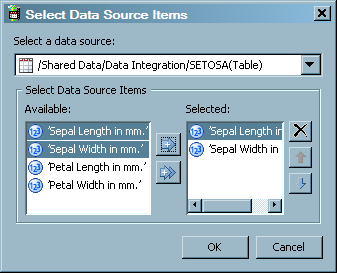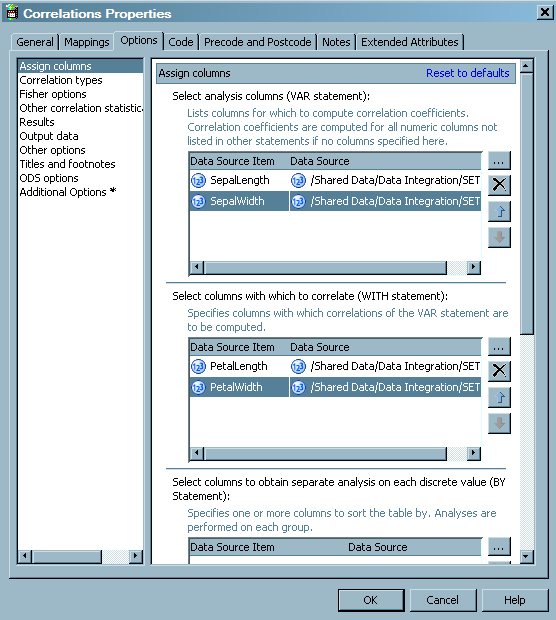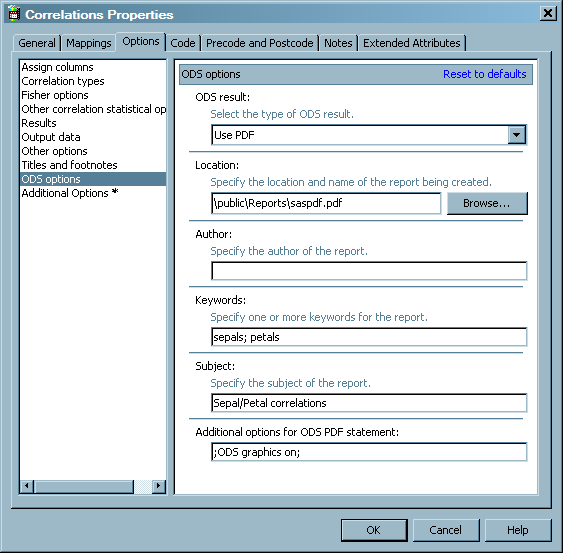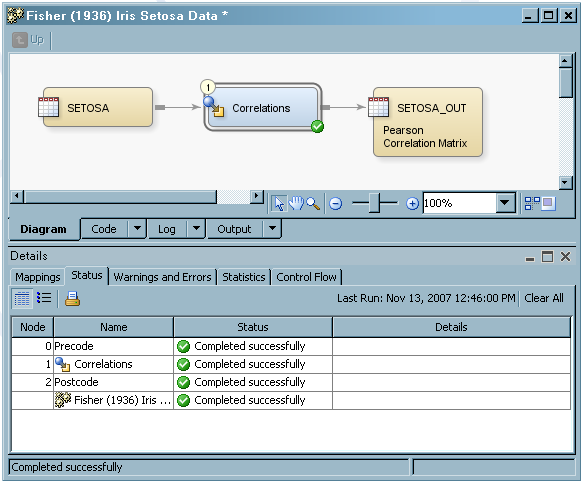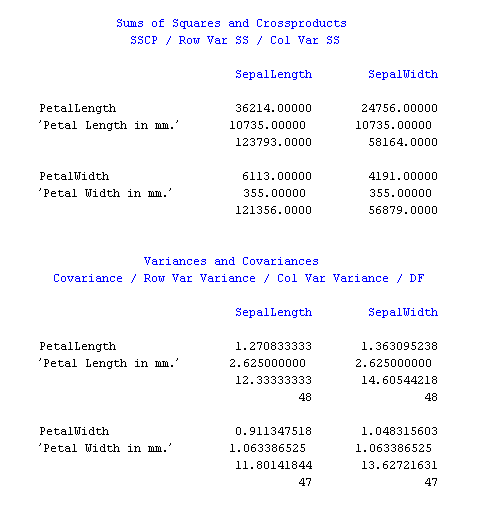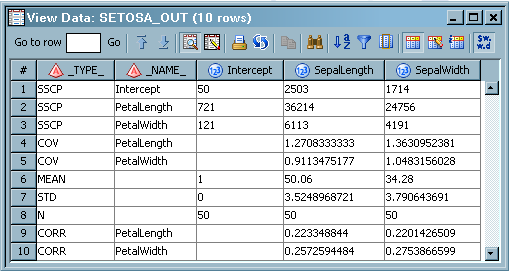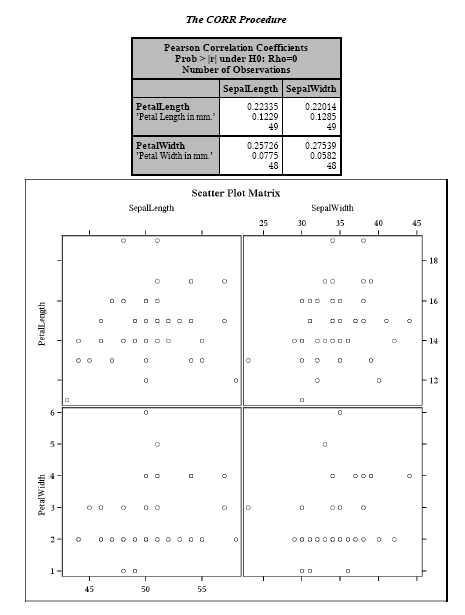Creating a Correlation Analysis
Overview
The Correlations transformation
generates one of the following types of correlation statistics:
-
Hoeffding
-
Kendall
-
Pearson
-
Spearman
The Correlations transformation
is based on the CORR procedure, which is documented in the Base SAS Procedures Guide: Statistical Procedures. The
CORR procedure computes Pearson correlation coefficients, three nonparametric
measures of association, and the probabilities associated with these
statistics. The correlation statistics include the following:
Pearson product-moment correlation is a parametric
measure of a linear relationship between two variables. For nonparametric
measures of association, Spearman rank-order correlation uses the
ranks of the data values and Kendall's tau-b uses the number of concordances
and discordances in paired observations. Hoeffding's measure of dependence
is another nonparametric measure of association that detects more
general departures from independence. A partial correlation provides
a measure of the correlation between two variables after controlling
the effects of other variables.
-
Pearson product-moment correlation
-
Spearman rank-order correlation
-
Kendall's tau-b coefficient
-
Hoeffding's measure of dependence, D
-
Pearson, Spearman, and Kendall partial correlation
You can specify which columns are correlated and which columns are analyzed. You can
group rows in the output based on the values in specified grouping columns. Output
appears in a target table or in the Output tab in the process designer. ODS output in the form of HTML, PDF, or RTF can also
be sent to a folder on the SAS Application Server that executes the job or to any folder that is accessible to that SAS Application Server.
The target receives data only for the source columns that are involved in the correlation. The target requires two columns that
the Correlations transformation populates: _TYPE_ specifies the type of the statistic
and _NAME_ identifies the correlation column.
The Correlations transformation requires that grouping columns be sorted in ascending
order in the source. If you specify grouping columns, you can sort those columns before
the Correlations
transformation by using a SAS Sort transformation.
Solution
You can use the Correlations transformation in a job that generates a correlation
analysis and creates an ODS document that contains its
results. This transformation uses the CORR procedure to compute Pearson correlation
coefficients, three nonparametric measures of association, and the probabilities associated
with these statistics. For example, you can create a job similar to the sample job
featured in this topic. Note that the output for this job is sent to a target table,
the Output tab in the Job Editor window, and an ODS
document that is configured in the job. This sample job generates
a correlation analysis that is based on a table of botanical data.
The sample job includes the following tasks:
Tasks
Create and Populate the Job
Perform the following steps to create and populate the job:
-
Right-click the Correlations transformation, and click Add Output Port from the Ports option in the drop-down menu. This step enables you to add an output port to the transformation.Note: If you want multiple statistical output tables, you must first set the correct number of tables in the Output data window in the Options tab of the Properties window. Once you have set the number of tables in the Output data window, add the same number of output ports to the transformation.
The following display shows a sample process flow diagram for a job that contains
the Correlations transformation:
Note that the source table for the sample job is named SETOSA and that the target
table is named SETOSA_OUT.
Configure Analytical Options
Use the Options tab in the properties window for the Correlations
transformation to configure the output for your analysis. Note that
the Options tab is divided into two parts, with a list of categories on the left-hand side and
the options for the selected category on the right-hand side. Perform the following
steps to set the options that you need for your job:
-
Click Assign columns to access the Assign columns page. Use the column selection prompts to access the columns that you need for your job. For example, you can click
 for the Select analysis columns (VAR
statement) to access the Select Data Source
Items window, as shown in the following display:
In the sample job, the VAR statement columns are SepalLength and SepalWidth. The column assignment options are shown in the following display:
for the Select analysis columns (VAR
statement) to access the Select Data Source
Items window, as shown in the following display:
In the sample job, the VAR statement columns are SepalLength and SepalWidth. The column assignment options are shown in the following display: -
Set the remaining options for your analysis in the appropriate fields. The sample job keeps the default Pearson product-moment correlation type and adds the COV and SSCP options on the Correlation type page. These options are enabled when you select Yes in the drop-down menu for the field and disabled when you select No.
-
Set any necessary options on the remaining analytical options pages. For example, the Update the metadata for the target tables option on the Additional Options page is enabled and default options for the Fisher options, Other correlation statistical options, Output data, Results, and Other options pages are retained. A reporting option is also set on the Other correlation statistical options page.
Configure Reporting Options
Use the remaining option pages to create and save a report that is based on the analysis
conducted in the job. Perform the following steps to set the reporting options:
-
Click ODS options to access the ODS options page. You can choose between HTML, RTF, and PDF output and enter appropriate settings for each. The sample job uses PDF output. Therefore, a location, a set of keywords, the subject of the report, and code to enable ODS graphics are added to the fields that are displayed when Use PDF is selected in the ODS Result field. (The path specified in the Location field is relative to the SAS Application Server that executes the job.) These fields are shown in the following display:Note: The plots for descriptive statistics option in the Plots option (PLOTS) field on the Other correlation statistical options page is also enabled. This step enables the inclusion of a scatter plot matrix in the PDF output.
Copyright © SAS Institute Inc. All rights reserved.

